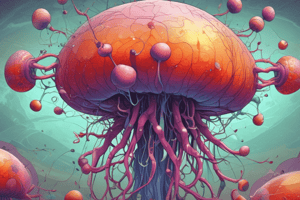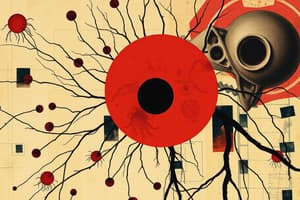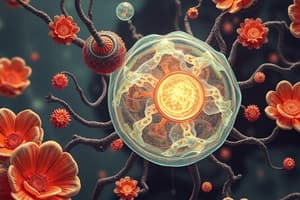Podcast
Questions and Answers
What are the two major mechanisms that regulate apoptosis?
What are the two major mechanisms that regulate apoptosis?
- Intrinsic and extrinsic pathways (correct)
- Cell growth and cell division
- Necrosis and autophagy
- Mitogenic and inhibitory pathways
Which family of proteins plays a crucial role in mediating apoptosis?
Which family of proteins plays a crucial role in mediating apoptosis?
- Proteasome family
- Bcl2 family (correct)
- MAP kinase family
- Cyclin family
How does cell proliferation relate to cell division?
How does cell proliferation relate to cell division?
- They are independent processes regulated by different factors. (correct)
- Cell proliferation is the direct outcome of cell division.
- Cell division depends solely on the intrinsic pathways.
- Cell proliferation requires growth factors but not mitogens.
What role do growth factors play in cellular processes?
What role do growth factors play in cellular processes?
What is the function of the protein kinase mentioned in the content?
What is the function of the protein kinase mentioned in the content?
What are extracellular growth factors known to influence?
What are extracellular growth factors known to influence?
Which compound is mentioned as having a therapeutic potential for treating certain diseases?
Which compound is mentioned as having a therapeutic potential for treating certain diseases?
What is a significant characteristic of apoptosis in animal cells?
What is a significant characteristic of apoptosis in animal cells?
What is the role of p53 when DNA damage occurs in cells?
What is the role of p53 when DNA damage occurs in cells?
Which of the following factors must be present for cellular proliferation to occur?
Which of the following factors must be present for cellular proliferation to occur?
How does the accumulation of p21 relate to DNA damage response?
How does the accumulation of p21 relate to DNA damage response?
What is the relationship between Bax and bcl2 in apoptosis regulation?
What is the relationship between Bax and bcl2 in apoptosis regulation?
What occurs to abnormal cells when DNA damage is severe and irreparable?
What occurs to abnormal cells when DNA damage is severe and irreparable?
What defines the physiological process of apoptosis?
What defines the physiological process of apoptosis?
How does the ATM/ATR kinase system respond to DNA damage?
How does the ATM/ATR kinase system respond to DNA damage?
What does a mutation in Ras typically lead to in the context of cell proliferation?
What does a mutation in Ras typically lead to in the context of cell proliferation?
What is the consequence of an imbalance between cell proliferation and apoptosis?
What is the consequence of an imbalance between cell proliferation and apoptosis?
What is the role of initiator caspases in the apoptosis process?
What is the role of initiator caspases in the apoptosis process?
What process is responsible for recycling functional macromolecules and eliminating harmful proteins in cells?
What process is responsible for recycling functional macromolecules and eliminating harmful proteins in cells?
Which statement best describes the relationship between protein structure and function in the context of procaspases?
Which statement best describes the relationship between protein structure and function in the context of procaspases?
What mechanism triggers apoptosis through cell surface death receptors?
What mechanism triggers apoptosis through cell surface death receptors?
Which type of autophagy specifically targets altered proteins for degradation?
Which type of autophagy specifically targets altered proteins for degradation?
What is one morphological feature that distinguishes apoptotic cells from necrotic cells?
What is one morphological feature that distinguishes apoptotic cells from necrotic cells?
What is the main purpose of mitophagy?
What is the main purpose of mitophagy?
What is the key characteristic of microautophagy?
What is the key characteristic of microautophagy?
What is a primary function of IAP (inhibitor of apoptosis) proteins concerning apoptosis?
What is a primary function of IAP (inhibitor of apoptosis) proteins concerning apoptosis?
Which feature is indicative of apoptotic cells during biochemical analysis?
Which feature is indicative of apoptotic cells during biochemical analysis?
Who was awarded the Nobel Prize in 2016 for discovering the mechanism of autophagy?
Who was awarded the Nobel Prize in 2016 for discovering the mechanism of autophagy?
How does phosphorylation primarily affect the conformation of proteins?
How does phosphorylation primarily affect the conformation of proteins?
What is the impact of cytochrome c relocation during apoptosis?
What is the impact of cytochrome c relocation during apoptosis?
Which apoptosis receptor is related to the monitoring of external death signals?
Which apoptosis receptor is related to the monitoring of external death signals?
What signifies the intrinsic pathway of apoptosis with respect to mitochondria?
What signifies the intrinsic pathway of apoptosis with respect to mitochondria?
What feature distinguishes apoptosis from necrosis during cell death?
What feature distinguishes apoptosis from necrosis during cell death?
What role do phagocytic cells play in apoptosis?
What role do phagocytic cells play in apoptosis?
Which statement accurately describes the process of autophagy?
Which statement accurately describes the process of autophagy?
What is a primary function of necroptosis?
What is a primary function of necroptosis?
How do necrotic cells primarily affect surrounding tissues?
How do necrotic cells primarily affect surrounding tissues?
What initiates the formation of an autophagosome?
What initiates the formation of an autophagosome?
What happens during the necrotic cell death process?
What happens during the necrotic cell death process?
In which scenario is apoptosis favored over necrosis?
In which scenario is apoptosis favored over necrosis?
Which cellular change is NOT characteristic of necrosis?
Which cellular change is NOT characteristic of necrosis?
What is the primary outcome of the autophagy process?
What is the primary outcome of the autophagy process?
Study Notes
Apoptosis Overview
- Apoptosis is a physiological process that regulates animal cell numbers through controlled cell death.
- Two main pathways of apoptosis: intrinsic and extrinsic, which are influenced by extracellular factors.
Mechanisms of Cell Growth and Division
- Cell proliferation equals cell division, influenced by extracellular growth factors that also promote cell growth.
- Different organisms may separate triggers for cell growth and division; some require both growth factors and nutrients.
- Protein kinases, such as mTOR, stimulate protein synthesis while inhibiting degradation.
Balance Between Cell Proliferation and Cell Death
- Coordination of cell proliferation and apoptosis is crucial for regulating tissue growth.
- Bax promotes apoptosis, while Bcl-2 supports cell survival; an equilibrium between these factors is essential for normal physiological processes.
DNA Damage and Apoptosis
- DNA damage can trigger apoptosis if repair mechanisms fail; this serves as protection against pathological conditions like cancer.
- Activation of the ATM/ATR kinase system phosphorylates p53, which promotes cell cycle arrest or induces apoptosis.
Caspases and Apoptosis
- Apoptosis is mediated by caspases, proteolytic enzymes that cleave specific proteins to induce cell death.
- Initiator caspases (e.g., caspases 8 and 9) activate effector caspases (e.g., caspases 3 and 7) to trigger the apoptotic cascade.
Extrinsic and Intrinsic Pathways
- The extrinsic pathway is initiated by cell surface death receptors (e.g., TNF-alpha, Fas, TRAIL).
- The intrinsic pathway involves mitochondrial signaling, with caspases activated regardless of the pathway.
Morphological Features of Apoptosis
- Characteristic features of apoptotic cells include chromatin condensation, nuclear fragmentation, and formation of apoptotic bodies.
- Apoptotic bodies are essentially vacuoles containing cytoplasm and intact organelles, which are eventually cleared by phagocytes.
Distinctions Between Apoptosis and Necrosis
- Apoptosis is a controlled process that avoids inflammation, while necrosis is accidental cell death that can damage surrounding tissues; necrotic cells release inflammatory signals.
- Key differences: apoptosis features chromatin condensation and organized cell death, while necrosis involves cell rupture and inflammation.
Alternate Cell Death Mechanisms
- Necroptosis is a form of programmed necrosis, often triggered in response to viral infections when caspase pathways are inhibited.
- Autophagy refers to the process of self-eating, wherein damaged organelles are degraded to prevent toxicity; it is more of a survival mechanism than a cell death process.
Role of Autophagy
- Autophagy involves formation of phagophores that encapsulate damaged organelles, fusing with lysosomes to degrade materials into reusable components.
- Proper autophagy is essential for cellular health; dysfunction can lead to various diseases.### Autophagy Overview
- Autophagy is a catabolic process essential for maintaining intracellular energy balance.
- It eliminates harmful proteins and damaged organelles, such as dysfunctional mitochondria.
- Functional macromolecules are recycled into cells, contributing to amino acid availability for cellular functions.
Types of Autophagy
- Macroautophagy: Classical form of autophagy that engulfs large cellular components.
- Chaperone-Mediated Autophagy (CMA): Targets altered proteins for degradation by delivering them to lysosomes.
- Microautophagy: Involves direct engulfment of cellular cargo by lysosomes for degradation.
Mitophagy
- Mitophagy is a specialized autophagic process focused on degrading abnormal mitochondria.
- Degradation of dysfunctional mitochondria plays a crucial role in various pathophysiological conditions.
Nobel Prize in Autophagy
- Yoshinori Ohsumi received the Nobel Prize in 2016 for elucidating the mechanisms of autophagy, significantly advancing understanding of cellular degradation processes.
Studying That Suits You
Use AI to generate personalized quizzes and flashcards to suit your learning preferences.
Description
This quiz focuses on the critical topic of apoptosis, exploring both the intrinsic and extrinsic pathways involved in cell death. We will discuss the regulatory mechanisms and physiological roles of apoptosis in maintaining proper cell numbers in animal organisms. Prepare to test your understanding of these vital cellular processes.




